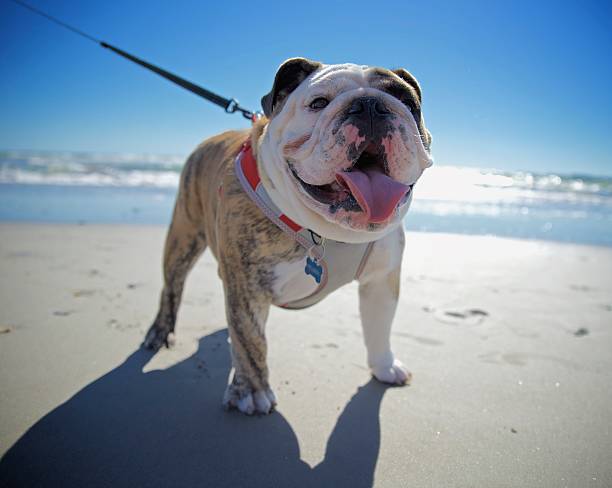The Boxer, a captivating symbol of athleticism, loyalty, and exuberant charm, captures the hearts of dog lovers and families across the world. With its impressive history, distinctive appearance, and boundless energy, this breed has carved out a treasured niche as a beloved companion and a shining example of canine strength and devotion.

| Category (Explanation) | Breed Information |
|---|---|
| Year of Breed Conception | 19th century |
| Country of Origin | Germany |
| Weight (Male) | 65-80 lbs (29.5-36 kg) |
| Weight (Female) | 50-65 lbs (23-29.5 kg) |
| Coat Type | Short, smooth |
| Color Variations | Various, including fawn, brindle, and white |
| Shedding Level | Low to moderate |
| Height (cm & in) | 21-25 inches (53-63.5 cm) |
| Breed Size | Medium |
| Trainability | High |
| Mental Needs | Moderate |
| Intelligence Level | High |
| Energy Level | High |
| Agility | High |
| Loyalty | High |
| Playfulness | High |
| Exercise Needs | Regular vigorous exercise |
| Guarding Proficiency | High |
| Sociability with Children | High |
| Barking Level | Moderate to high |
| Digging Tendency | Low to moderate |
| Destructive Behavior | Low to moderate |
| Drooling Level | Moderate |
| Obedience Level | Moderate to high |
| Apartment Friendly | Yes, with proper exercise and space |
| Inherent Prey Drive | Moderate |
| Physical Risk to Others | Low |
| Travel Fatality Risk | Low |
| Allergen Potential | Low (considered hypoallergenic) |
| Health Concerns | Hip dysplasia, cancer, heart issues |
| Average Life Expectancy | 10-12 years |











































































Woof Mastery is reader supported and our articles may contain affiliate links.
Instead of running third party ads that we have no control of we only use links from high-quality companies we are directly partnered with. Making use of these links come at no cost to you our reader, and in many cases have the extra benefit of discounted rates or sign up bonuses.
If you’re interested you can read more about our affiliate policy here.
We appreciate your support and always insure that the products and services we recommend are high-quality, helpful and relevant to the subject at hand!
The Boxer’s history is a journey that takes us back to 19th-century Germany. Developed by crossing various breeds, including the Bullenbeisser and English Bulldog, the Boxer was initially used for hunting large game.
However, they soon found their calling as versatile working dogs. Their physical prowess, determination, and innate intelligence made them indispensable to soldiers during both World Wars. Boxers have also excelled as loyal family companions.
Today, they are cherished worldwide for their courage, loyalty, and their deep connection with humans, embodying the enduring spirit of German craftsmanship and devotion.

What sets the Boxer apart is its boundless energy, intelligence, and playful spirit. These dogs are known for their athleticism and strong sense of loyalty to their families. Boxers combine their athletic prowess with a loving disposition, making them exceptional companions and protectors. Their joyful and affectionate nature makes Boxers truly special.
Their traditional roles included hunting and working on farms, but they have transitioned into loyal and protective family dogs.
Boxers are renowned for their lively and playful personalities. They are highly loyal, deeply affectionate, and exceptionally protective of their families.
These dogs are known for their boundless energy and enthusiasm, making them wonderful playmates for children. Boxers have an incredible capacity for joy and playfulness, often displaying a sense of humor that can brighten any day. Their intelligence and eagerness to please make them relatively easy to train, and they thrive on positive interactions with their owners.
While they may be cautious around unfamiliar faces, their loyalty to their owners is unwavering, and they are always up for a game of fetch or a loving cuddle. Boxers truly embody the ideal combination of strength and affection in a dog breed, making them not just protectors but also lifelong companions full of exuberance and love.
Boxers are known for their affectionate, loyal, and energetic temperament. While they are typically friendly and devoted to their families, they may exhibit protective instincts that require training and socialization to avoid overprotectiveness. Territorial behavior and occasional stubbornness can be managed with consistent and patient training methods.
Due to their strength and athleticism, leash training is essential. Proper socialization often results in amiable interactions with other dogs and people, reflecting their well-adjusted and loving nature. Boxers are both playful and protective, making them exceptional companions for active families.
Boxers are medium to large-sized dogs, celebrated for their powerful and balanced physique. They sport a square-shaped head with a well-defined, broad jaw and muscular cheeks, presenting an alert and friendly expression.
Their eyes, typically brown, are round and expressive, radiating intelligence. Boxers’ ears are medium-sized, set high, and naturally fold forward, enhancing their alert appearance.Their short, smooth coat comes in various colors, with fawn and brindle being common.
The coat accentuates their well-muscled, compact body. Boxers possess a robust, muscular neck, leading to a broad chest and strong, straight legs. Their tail is carried high and may be docked.
In terms of size, males typically stand between 23 to 25 inches (58-64 cm) at the shoulder, while females are slightly smaller. Weight ranges from 50 to 80 pounds (23-36 kg) for males, with females being lighter.
Overall, boxers project an athletic, agile presence, reflecting their history as versatile working dogs and beloved family companions. Their appearance exudes confidence, strength, and a friendly disposition.
Boxers are known for their striking and athletic appearance, with several color varieties, including:
Boxers have a low shedding level. They are not considered heavy shedders, and their shedding is typically minimal throughout the year. Regular grooming and brushing with a soft bristle brush can help manage shedding and maintain their coat’s health.
Factors that affect shedding in Boxers are genetics and skin health. Maintaining proper skin care and addressing any dermatological issues can help minimize shedding. A balanced diet rich in essential nutrients is crucial for overall coat health and shedding control.
Boxers have a distinct, tight-fitting coat that showcases their athletic physique. While short-coated, this breed sheds more than one might expect.
Brushing: Weekly brushing using a rubber grooming mitt not only removes loose hair but also invigorates their skin, boosting circulation and overall coat health.
Bathing: Generally, a bath every 6-8 weeks will suffice, but if your Boxer loves outdoor activities, you might need to adjust the frequency. When bathing, ensure all soap is rinsed out to avoid skin irritation.
Ears: Their ears, though naturally floppy, stand slightly away from the head, potentially allowing debris or moisture to accumulate. Clean them weekly with a vet-approved solution.
Nails: Like all breeds, regular trimming is essential. If you hear them clicking on the floor, it’s time for a trim.
Teeth: Boxers are prone to dental issues, so brushing their teeth multiple times a week can’t be emphasized enough. Use dog toothpaste and a suitable brush for effectiveness.
Wrinkle Care: They have a slightly wrinkled face, so regular cleaning, especially after meals, is important.
Eye Care: Boxers have expressive eyes. Ensure they’re clear and bright. Clean away any crust or discharge daily.
Boxers have a high activity level. They are known for their boundless energy and playful nature. Here are some key points to consider about their activity level:
Boxers are moderately intelligent dogs, characterized by their problem-solving abilities, adaptability, and a strong desire to please their owners. Here are some key points about their intelligence:
While Boxers may not top the list in terms of problem-solving or obedience, their intelligence is well-suited for being affectionate and protective companions. Training and mental stimulation are essential to help them reach their full potential.
Boxers have a keen intellect and yearn for stimulating activities. Offer them toys and exercises that mentally challenge them, like scent-tracking, tug-of-war, or agility courses.
Social Interaction: A boxer’s jovial nature necessitates daily social interactions. Deprivation from companionship can result in despondency.
Exercise: Physical exertions don’t just keep them fit; they’re essential for their cognitive health. A daily run or playtime can significantly elevate their mood.
Training and Obedience: Boxers, with their enthusiasm, prosper under structured training sessions that challenge their minds and nurture their bond with their handler. Positive reinforcement techniques work wonders with them.
Routine and Structure: Boxers derive comfort from predictable routines, which instill a feeling of security and diminish uncertainties.
Affection and Attention: Shower your Boxer with love and dedicated playtimes. They’re known for their playful disposition and thrive when engaged.
Socialization: Introducing them to varied environments and beings from a young age ensures they mature into confident and sociable dogs.
Safe Environment: Crafting a secure and calming space for them at home is paramount, where they can seek refuge during overwhelming moments.
Consistency: Regularity in training regimes and schedules boosts their confidence and understanding of their surroundings.
Enter The Woof Mastery

Before welcoming a Boxer into your home, it’s important to understand their unique needs. Boxers are known for their playful and energetic personalities. They require regular exercise and mental stimulation to thrive. Training and socialization are vital to harness their strong, protective instincts.
Be prepared for potential health concerns, including heart conditions. Grooming needs are relatively low. Responsible ownership involves providing a loving and active environment for these loyal and dynamic companions.
Boxers, known for their boundless energy and affectionate nature, have the potential to pose a physical danger if they aren’t properly socialized, trained, or managed. Behavior is shaped by factors like temperament, upbringing, training, and owner dedication. Here’s their potential danger assessment:
Boxers are renowned for their lively and playful personalities. They are highly loyal, deeply affectionate, and exceptionally protective of their families.
These dogs are known for their boundless energy and enthusiasm, making them wonderful playmates for children. Boxers have an incredible capacity for joy and playfulness, often displaying a sense of humor that can brighten any day. Their intelligence and eagerness to please make them relatively easy to train, and they thrive on positive interactions with their owners.
While they may be cautious around unfamiliar faces, their loyalty to their owners is unwavering, and they are always up for a game of fetch or a loving cuddle. Boxers truly embody the ideal combination of strength and affection in a dog breed, making them not just protectors but also lifelong companions full of exuberance and love.
Boxers, recognized for their boundless energy and muscular frame, exhibit unique swimming capabilities. Here are pertinent factors:
Many Boxers can learn to swim and might even revel in water play, but it’s essential to be vigilant and prioritize their well-being during any water-based activities.
Boxers, in line with other dogs, produce various vocalizations they use for expression and communication. Here’s a look into the sounds associated with them:
For Boxer owners, comprehending their dog’s vocalizations and the reasons behind them is vital. While many are expressive, others could indicate a need or discomfort. Employing positive reinforcement can be invaluable in managing their vocal behavior.
Boxers thrive in homes where they receive love, structure, and opportunities for physical and mental stimulation. Here are some ideal living conditions for Boxers:
Challenges:
When it comes to travel fatality risk for Boxers, consider the following potential constraints:
By keeping these tips in mind, traveling with your Boxer can be much safer.
Boxers may be prone to specific health concerns. While not all individuals will experience these issues, it’s essential for Boxer owners to be aware of potential health problems and work with veterinarians to maintain their pets’ well-being. Common health concerns in Boxers include:
Regular veterinary check-ups, a balanced diet, proper exercise, and responsible breeding practices can help mitigate some of these health concerns. It’s crucial for Boxer owners to work closely with their veterinarians to monitor their pets’ health and address any issues promptly.
Proper nutrition is paramount for the health and well-being of Boxers. Here are some nutritional habits and best practices tailored to this breed:
Breed-Specific Laws (BSL): Boxers, while generally recognized as family-friendly dogs, can occasionally be affected by breed-specific laws (BSL) in certain regions. These laws are established primarily at the local or city level and may differ from one area to the next.
Types of Restrictions: For Boxers, potential BSL restrictions could encompass mandatory spaying/neutering, special licensing, liability insurance mandates, requirements for muzzling in public, and sometimes, prohibitions on ownership, all depending on the specifics of the local ordinance.
Rationale for BSL: BSLs are often a response to concerns over public safety with particular breeds, especially if any negative incidents arise. Even though Boxers are largely loyal and playful, misunderstandings about their nature can sometimes lead to BSL considerations.
Controversy: BSL remains contentious, with arguments suggesting that these laws tend to generalize breeds instead of addressing individual dog behavior. The emphasis, many believe, should be on responsible ownership and education.
Local Regulations: Anyone wishing to own a Boxer should first familiarize themselves with any local breed-specific regulations, consulting their local animal control or governmental bodies.
Woof Mastery is reader supported and our articles may contain affiliate links.
Instead of running third party ads that we have no control of we only use links from high-quality companies we are directly partnered with. Making use of these links come at no cost to you our reader, and in many cases have the extra benefit of discounted rates or sign up bonuses.
If you’re interested you can read more about our affiliate policy here.
We appreciate your support and always insure that the products and services we recommend are high-quality, helpful and relevant to the subject at hand!
Myth 1: Boxers are Aggressive by Nature
Myth 2: They are High-Energy Dogs
Myth 3: They Can’t Tolerate Cold Weather
Myth 4: They are Not Good with Children
Myth 5: They Shed Excessively
Myth 6: They Don’t Require Training
Myth 7: They are Always Good with Other Dogs
Myth 8: They Are All the Same Size
Myth 9: They are Unhealthy Dogs
Myth 10: They are Always Clingy
The Boxer holds cultural significance in various contexts:
While there may not be as many famous Boxer owners as there are for other dog breeds, here are a few notable individuals who have been associated with Boxers:
Boxers, like many other dog breeds, have faced several threats and challenges over the years. Some of the significant threats and issues that have affected the breed include:
The Boxer is believed to have been developed from a combination of various breeds, with the primary ancestors being the Bullenbeisser and the Bulldog. The breed’s development took place in Germany, influenced by the need for a strong working and hunting companion. The specific breeds and strains that contributed to the Boxer’s development include:
Boxers are the epitome of energy and affection, embodying the spirit of cherished family pets. Their robust physique and loving disposition make them exceptional companions. These dogs are known for their loyalty and adaptability, seamlessly integrating into our lives and providing both security and heartfelt devotion. Boxers are excellent watchdogs, displaying protective instincts that solidify their role as guardians of our homes.
Their playful and patient nature makes them perfect playmates for families with children. Boxers thrive in various living conditions and demand only minimal grooming, making them ideal for busy households. Their athletic prowess caters to active individuals and families, and their intelligence allows them to excel in activities and training.
Beyond their physical attributes, Boxers bring a unique charm to every household, filling the air with their playful presence. Their versatility is a testament to their adaptability, transitioning effortlessly from beloved family pets to diligent working dogs.
Above all, Boxers offer an unparalleled gift—profound and unconditional love. They become treasured family members, enriching our lives with their unwavering companionship and forging an unbreakable bond that lasts a lifetime. Embrace the incredible love and devotion that Boxers have to share.